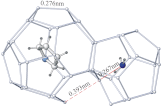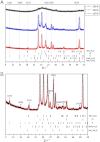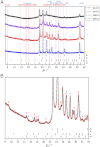Ammonia clathrate hydrates as new solid phases for Titan, Enceladus, and other planetary systems
- PMID: 22908239
- PMCID: PMC3443173
- DOI: 10.1073/pnas.1205820109
Ammonia clathrate hydrates as new solid phases for Titan, Enceladus, and other planetary systems
Abstract
There is interest in the role of ammonia on Saturn's moons Titan and Enceladus as the presence of water, methane, and ammonia under temperature and pressure conditions of the surface and interior make these moons rich environments for the study of phases formed by these materials. Ammonia is known to form solid hemi-, mono-, and dihydrate crystal phases under conditions consistent with the surface of Titan and Enceladus, but has also been assigned a role as water-ice antifreeze and methane hydrate inhibitor which is thought to contribute to the outgassing of methane clathrate hydrates into these moons' atmospheres. Here we show, through direct synthesis from solution and vapor deposition experiments under conditions consistent with extraterrestrial planetary atmospheres, that ammonia forms clathrate hydrates and participates synergistically in clathrate hydrate formation in the presence of methane gas at low temperatures. The binary structure II tetrahydrofuran + ammonia, structure I ammonia, and binary structure I ammonia + methane clathrate hydrate phases synthesized have been characterized by X-ray diffraction, molecular dynamics simulation, and Raman spectroscopy methods.
Conflict of interest statement
The authors declare no conflict of interest.
Figures




References
-
- Lunine JI, Stevenson DJ. Clathrate and ammonia hydrates at high pressure: Application to the presence of methane on Titan. Icarus. 1987;70:61–77.
-
- Fortes AD, Choukroun M. Phase behavior of ice and hydrates. Space Sci Rev. 2010;153:185–218.
-
- Loveday JS, et al. Stable methane hydrate above 2 GPa and the source of Titan’s atmospheric methane. Nature. 2001;410:661–663. - PubMed
-
- Tobie G, Lunine JI, Sotin C. Episodic outgassing as the origin of atmospheric methane on Titan. Nature. 2006;440:61–64. - PubMed
-
- Choukroun M, Grasset O, Tobie G, Sotin C. Stability of methane clathrate hydrates under pressure: Influence on outgassing processes of methane on Titan. Icarus. 2010;205:581–593.
Publication types
MeSH terms
Substances
LinkOut - more resources
Full Text Sources
Other Literature Sources
Molecular Biology Databases

